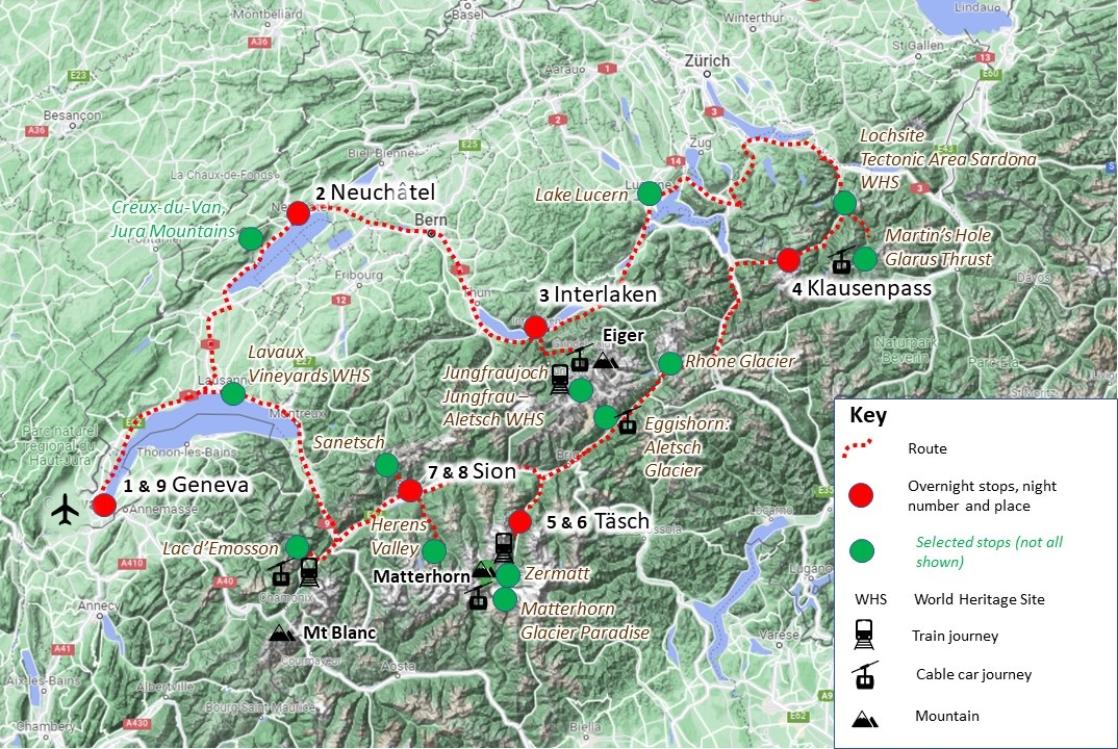Switzerland
An Alpine Adventure
Geneva TO Geneva
Exclusive small group tour. Number of participants : 8-14
8 - 16 July 2026 *FULL* (waitlist available)
10 days/9 nights
£2,995
* * * * * * *
Prices are per person, based on 2 people sharing a room. Single supplement applies, please make contact for details.
Includes all rail and cable car fares
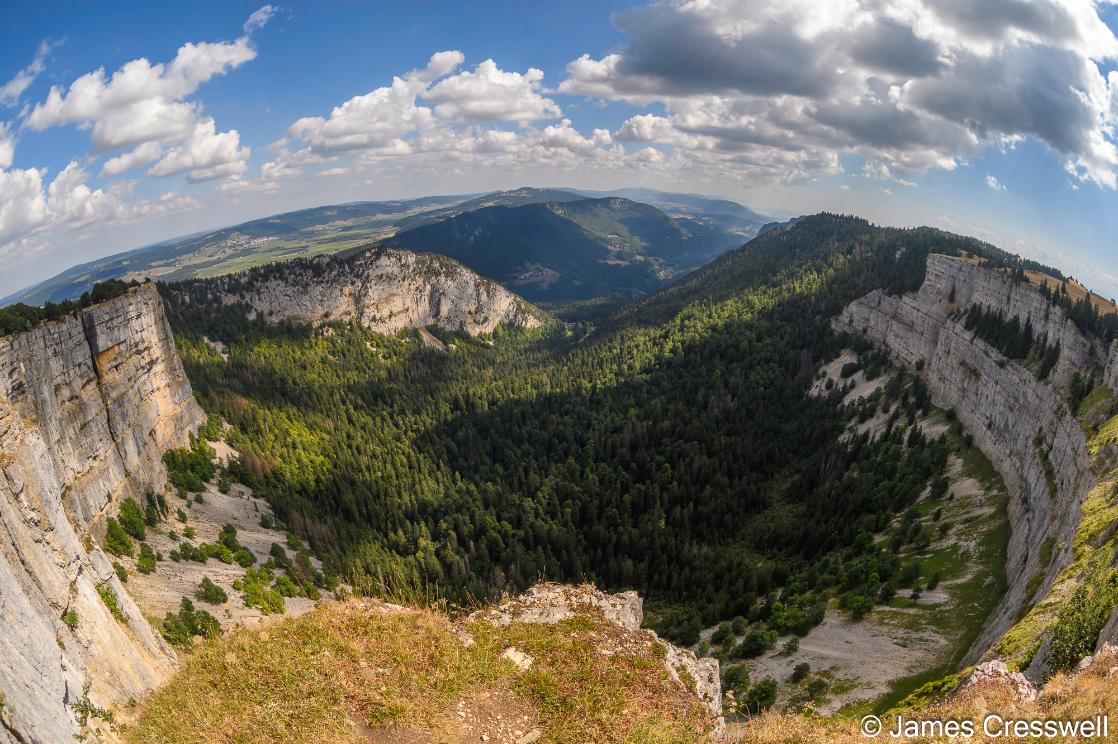
Day 2:Creux-du-Van in the Jura Mountains, the type area of the Jurassic period
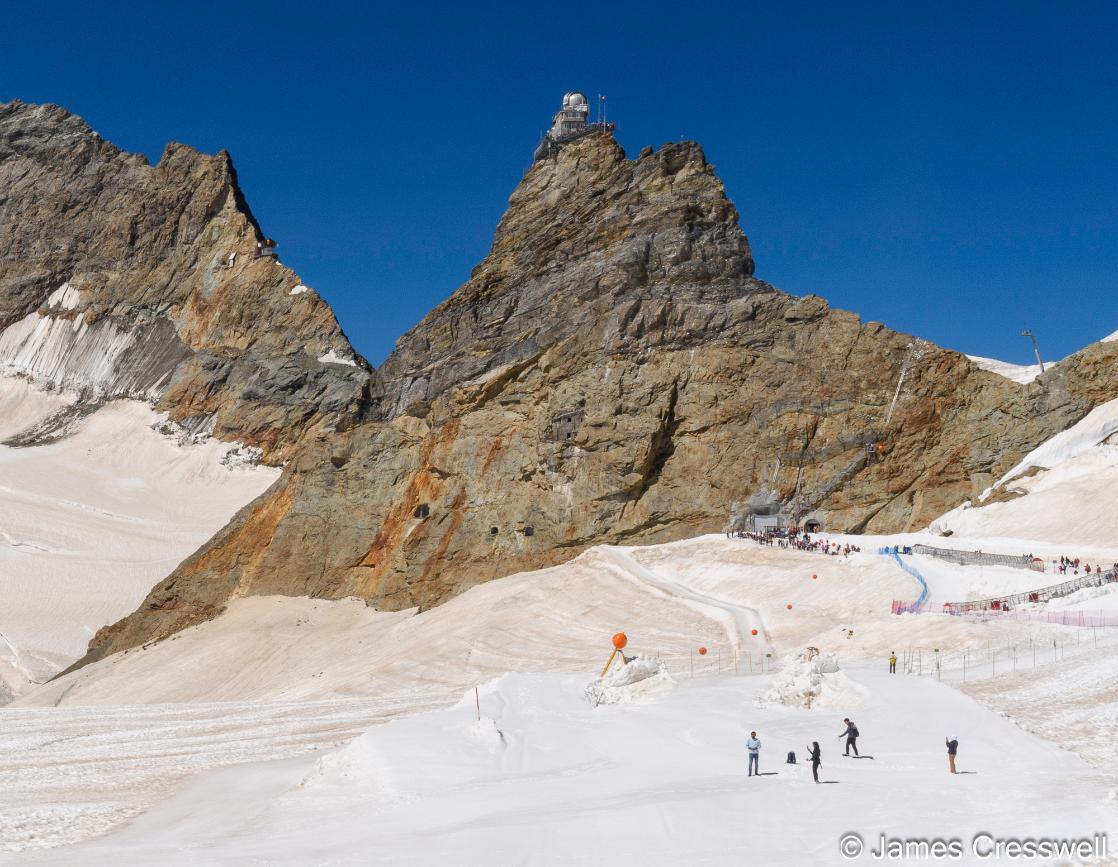
Day 3: Jungfraujoch the highest trainstation in Europe, in the Jungrauu-Aletsch UNESCO World Heritage Site
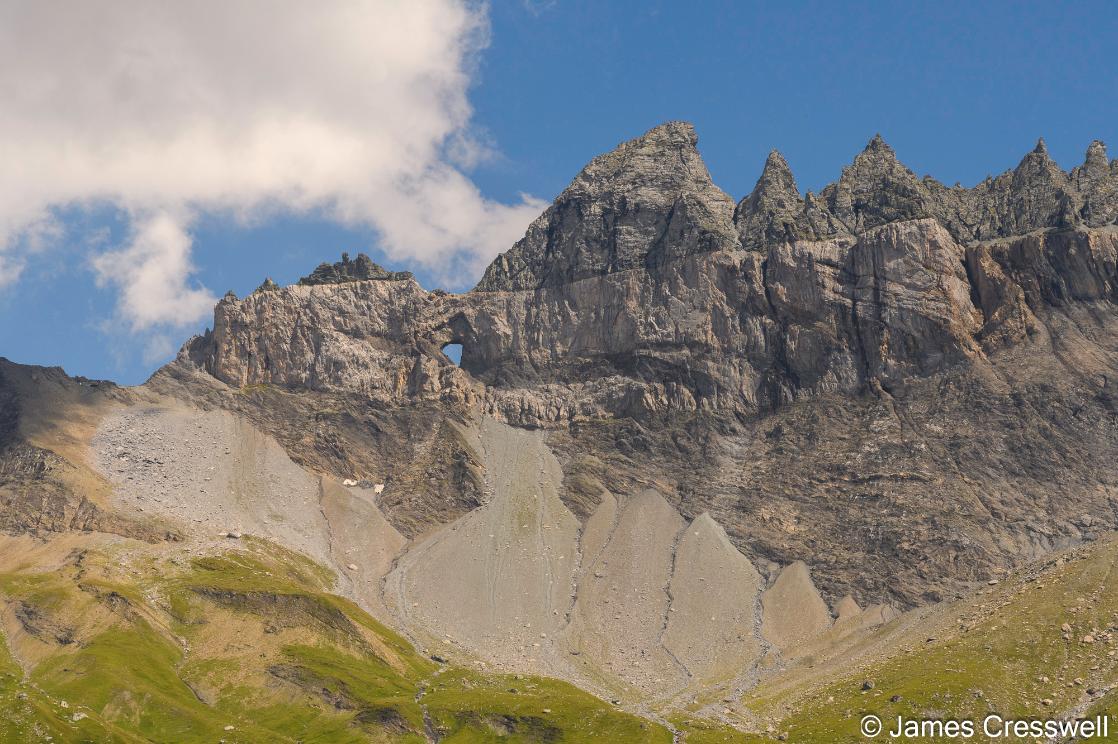
Day 4: The Glarus thrust and Martin's Hole in the Techtonic Area Sardona UNESCO World Heritage Site
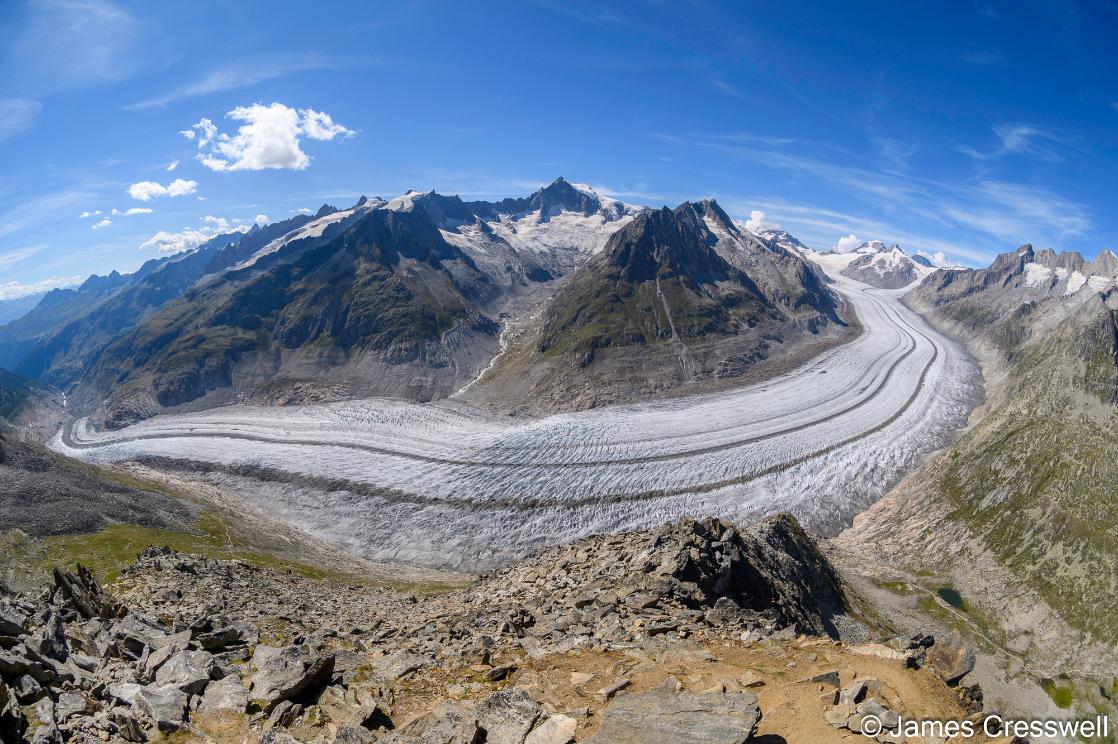
Day 5: The Aletsch Glacier in the Jungfrau-Aletsch UNESCO World Heritage Site
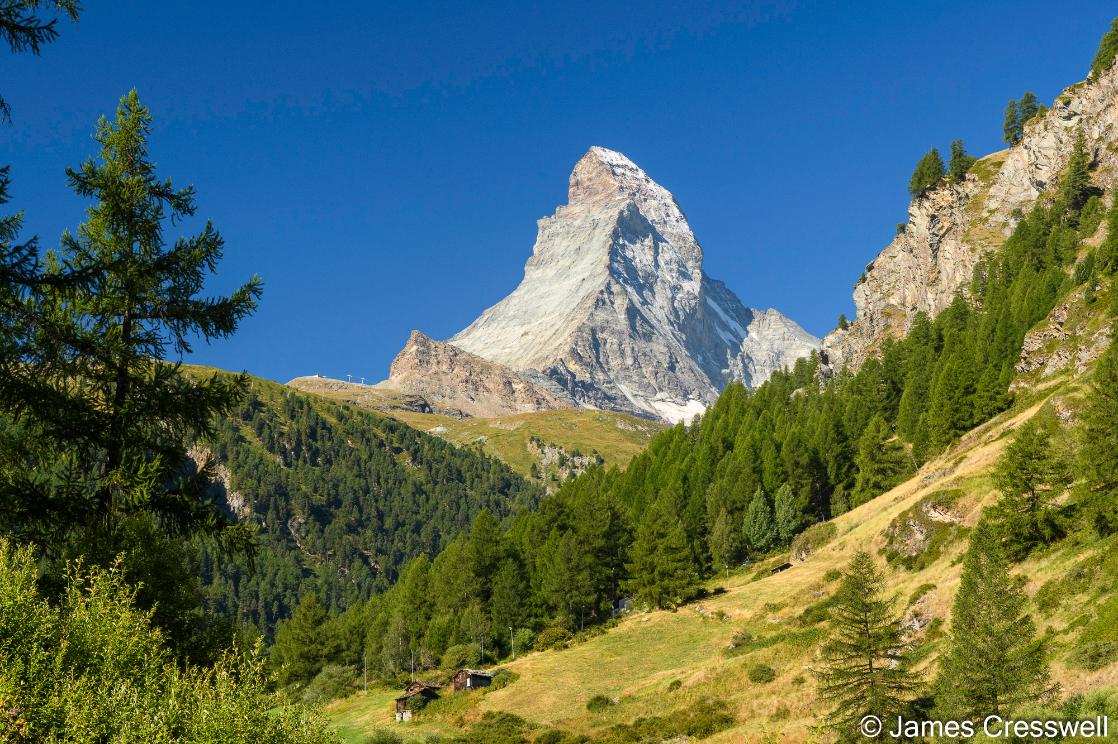
Day 6: The Matterhorn
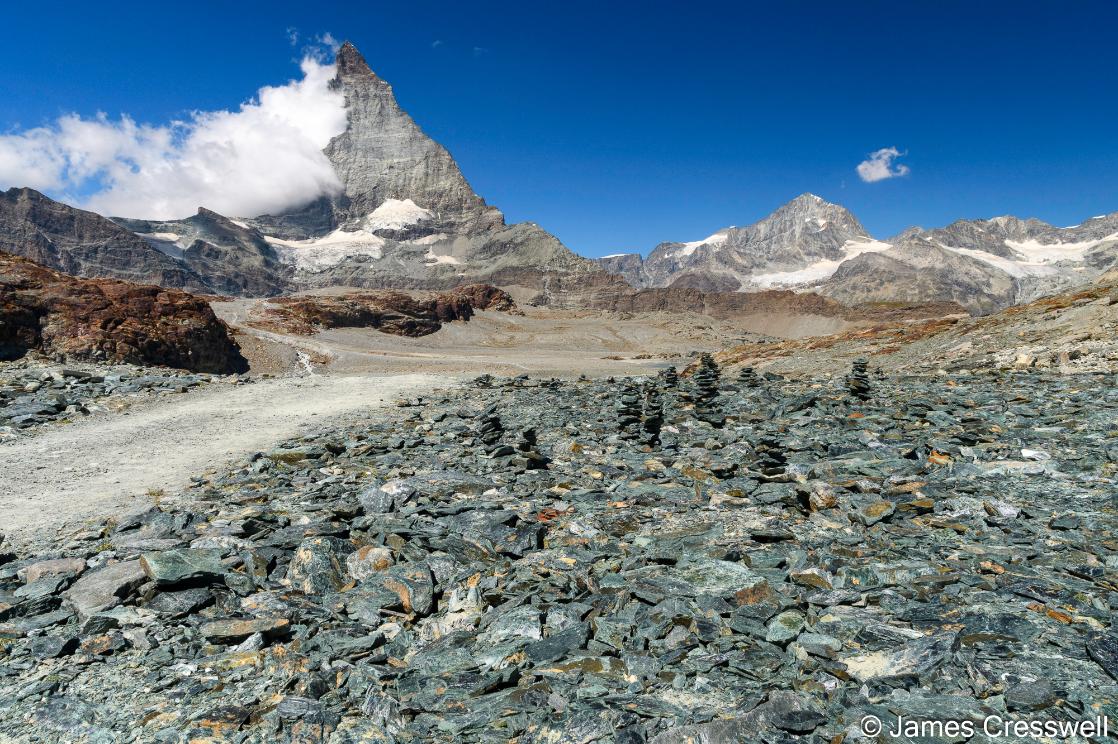
Day 6: Ophiolitic rocks in the foreground with the Matterhorn in the background
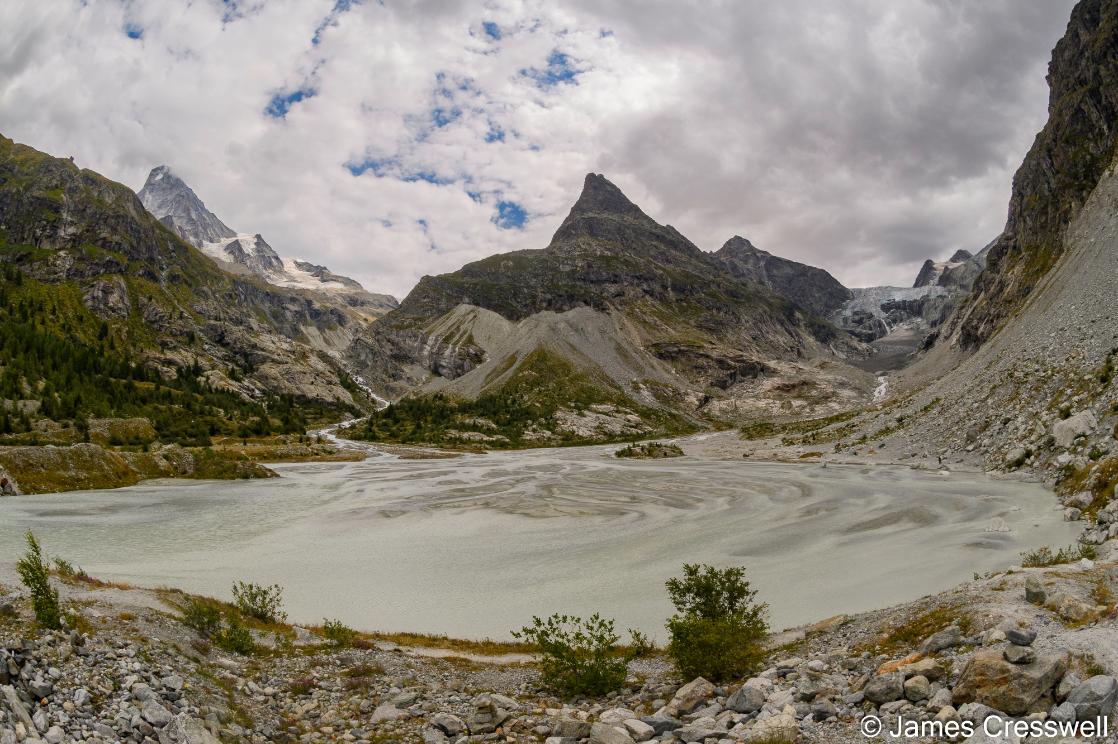
Day 7: Rocks that were once part of the African continent in theHerens Valley
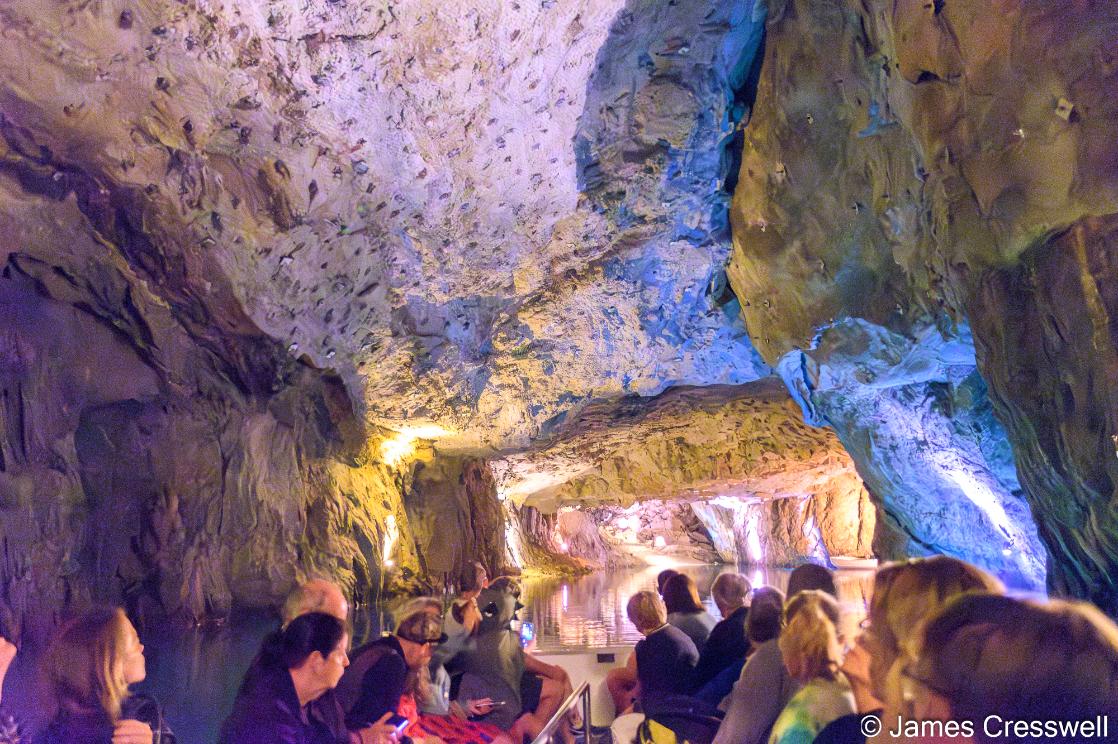
Day 8: On the boat tour in the Saint Leonard Subterranean Lake
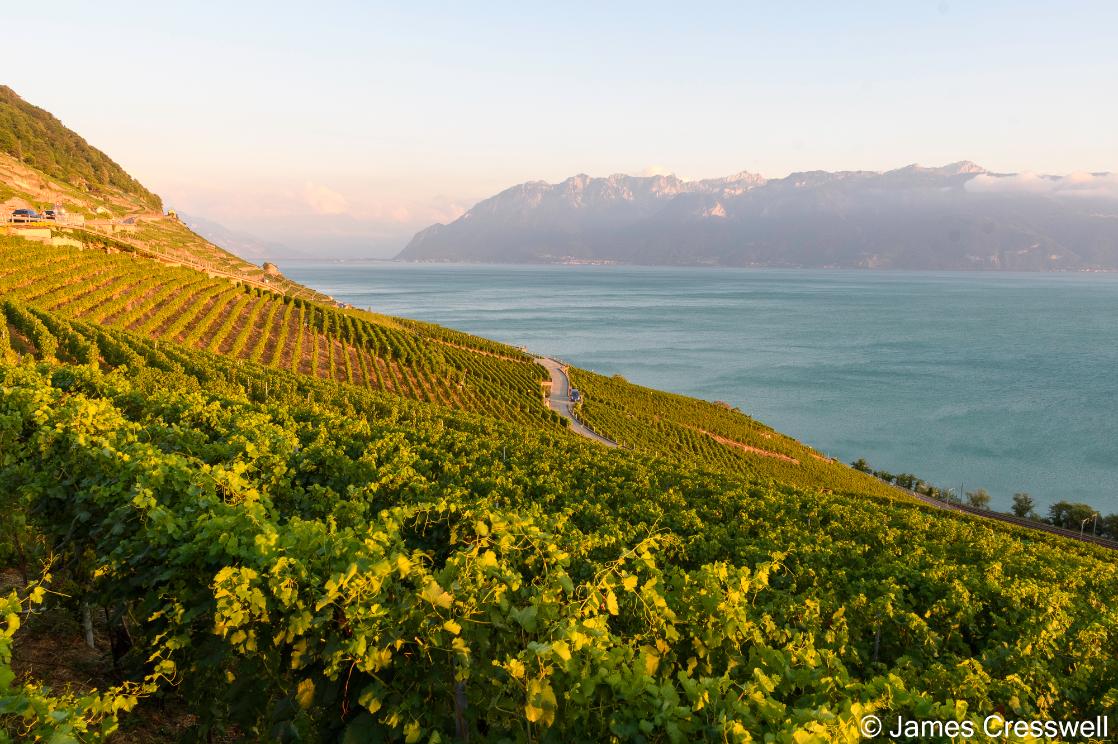
Day 9: Lavaux Vineyard Terraces UNESCO World Heritage Site on the shore of Lake Geneva
Itinerary
Day 1: Arrival in Geneva. We will be staying at a hotel near Geneva Airport and we will meet for a welcome meeting in evening at the hotel.
Day 2: Neuchâtel and the Jura Mountains. Our tour starts by journeying along the shore of Lake Geneva, a glacial lake and the largest lake in the Alps which is partly in France and partly in Switzerland. We then reach another lake, Lake Neuchâtel, which is the largest lake wholly in Switzerland. We leave its shores to climb up into the Jura Mountains that lend their name to the Jurassic Period. Our first stop is Creux-du-Van, a glacially eroded, horseshoe-shaped limestone cliff of enormous proportions. The vertical rock face is 160m high and surrounds a valley that is 4 km long and 1.4 km wide. At this site we learn about the folded structures of the Jura Mountains and get spectacular views to the Alps. Next, we visit a historically important glacial erratic named Pierre à Bot. The boulder originated in the Mount Blanc massif and was carried to its present position in the last Ice Age. Switzerland's most famous geologist, Louis Agassiz, used it to defend his theory of glaciation and requested it to be classified as a "precious monument of natural history". Next, we visit the nearby town of Valangin and see the type locality of the Valanginian epoch of the Cretaceous period. The rest of the day is spent in Neuchatel where we take a town walk and visit the historic Natural History Museum in Neuchâtel, with which Agassiz also had strong connections. The night is spent in Neuchâtel.
Day 3. The Top of Europe in Jungfrau – Aletsch World Heritage Site. Our first stop today is the shore of the Thunersee. We then travel to Grindelwald in the Bernese Alps, where we can gaze on the gigantic 10km long north wall of the High Alps. Centred on the Eiger, Mönch and Jungfrau peaks, it is a scenically superlative and is globally recognised as the Swiss Alps Jungfrau-Aletsch World Heritage Site. From Grindelwald we travel by train and/or cable car to the highest station in Europe, Jungfraujoch. The station lies at an elevation of 3,463m on a saddle between the Jungfrau and Mönch mountains. From the top we get incredible views of the most glaciated part of Europe including the Alps' longest glacier as well as a range of other classic glacial and geologic features. The whole day is spent in the area, with the night in nearby Interlaken.
Day 4. Lake Lucerne & the Tectonic Area Sardona World Heritage Site. In the morning we pass through the extraordinarily diverse landscape of Lake Lucerne stopping at several viewpoints to learn about the geology of the Pilatus, Stanserhorn, and Mythen mountains and the associated Penninic and Helvetic nappe systems. At lunchtime we reach Glarus in the Tectonic Area Sardona Unesco World Heritage Site. The Tectonic Arena Sardona is recognized by UNESCO because it provides an exceptional display of mountain building tectonics and has been recognised as a key site for geological sciences since the 18th century. Its most famous exposure is the Glarus Overthrust which we will spend the afternoon examining. Our first stop in the area is arguably the most famous geological outcrop in Switzerland: Lochsite. Here 250-300 million-year-old rocks lie above younger, 35-50 million-year-old rocks. The site has been studied for over 200 years and has revolutionised the understanding of mountain building, with the recognition that overthrusting plays a key role. We then take the cable car from Elm to Tschinglen Alp to make a short hike to Firstboden for magnificent views of the Glarus thrust and Martin's Hole. The night is spent at the Klausenpass (1,948m).
Day 5. Rhone Glacier & Return to the Jungfrau – Aletsch World Heritage Site. Our first stop is the entrance to the Gotthard Tunnel, before continuing to the Rhone Glacier. The Glacier is the source of the River Rhone and due to its accessibility next to the road has a well documented response to climate change. It has retreated 1,300m in the last 120 years! Next we arrive in the town of Fiesch and by way of two cable cars return to the Jungfrau - Aletsch World Heritage Site. At the Eggishorn viewpoint we gaze down up the Aletsch glacier from a midway point (see photo). The Aletsch Glacier is the largest, longest and most famous glacier in the Alps. We then stay in Täsch near Zermatt for the next two nights.
Day 6. Zermatt & The Matterhorn. Today we take a train to the famed mountaineering and ski resort of Zermatt. The village lies on ophiolitic rocks that formed beneath the oceanic crust of the ancient Tethys Ocean. Towering above the village is the Alps' most iconic peak the Matterhorn, a rocky pyramid in superb isolation from surrounding 4000m peaks. The rock itself has an African origin and the Zermatt region allows us to learn all about the European African collision that closed the Tethys ocean and forced up the Alps. We take Europe's highest cable car to just below the 3,883m summit of Klein Matterhorn, where we get an unusual perspective of the oceanic nappe while traversing a tunnel bored through green rock riddled with white veins — battle scars from the rock’s tortuous tectonic history. The tunnel continues through the glacial ice, giving you an excellent glimpse of its annual layers. We then descend from this summit to a lower station and start the Matterhorn Glacier Trail. It’s a delightful wander through mangled oceanic crust recently exposed by the retreat of the Theodul and Furgg glaciers, with the Matterhorn looming above you the entire way. The trail has interpretive signs describing the various oceanic rocks you pass en route, including dense, garnet-bearing eclogite and green serpentinite, the result of of metamorphic transformations, from water being incorporated into the crystal structures of mantle and oceanic crustal rocks to burial down to 70km below the Earth’s surface. At the end of the trail we return to Zermatt by cable car, and then on to Täsch for a second night.
Day 7. Hérens Valley. Today we take a day trip from Sion into the Hérens Valley, to learn more about European/African suture with evocative geology that includes greenschists (oceanic remnants), and some of the most amazing glacial landscapes of Switzerland. We spend the night in the historic town of Sion.
Day 8. Area around Sion. Our first stop of the day is Sanetsch. Here we see a Tertiary unconformity marking the onset of the Alpine orogeny, 2,000m high volcaniclastic turbidites and views of large-scale folds close to the famous Morcles nappe. Next we visit the Saint-Léonard underground lake. This formed where a bed of Triassic gypsum, emplaced within impervious Carboniferous strata, was dissolved by groundwater. We then return to Sion to see Valère and Tourbillon castles and to spend a second night.
Day 9. Views of Mount Blanc and Lavaux Vineyard Terraces UNESCO World Heritage Site. In the morning we drive to Châtelard. Here take two different funiculars and a train to reach the Emosson Dam. The first has a gradient of up to 87%, making it one of the steepest funiculars in the world! The panoramic train offers grandiose views of the entire Mont Blanc massif. The last funicular takes us up another 140m for even better views of Mt Blanc. Next we visit the impressive 200m deep Trient Gorge taking a walk through it before heading to the Lavaux Vineyard Terraces WHS. Here hard conglomerate layers and softer sandstone layers dating back to Oligocene sedimentation of large alluvial fans have been differentially eroded by the Rhone glacier and form a steep, stair-like slope that forms the vineyard terraces. Finally we arrive back in Geneva for the final night of the tour.
Day 10. Depart.
INCLUDED
Geological guiding from James Cresswell
Transportation from destination to destination, either by train, cable-car or car
Hotel accommodation
Breakfast in the hotels
Entrance to all attractions except those visited on free time
NOT INCLUDED
Flights
Transfer to/from Geneva Airport to hotel
Lunches and dinners
Trip diaries, photo galleries and reviews of previous trips
Photo Diary 2024
A selection of the best photos from the trip, with captions
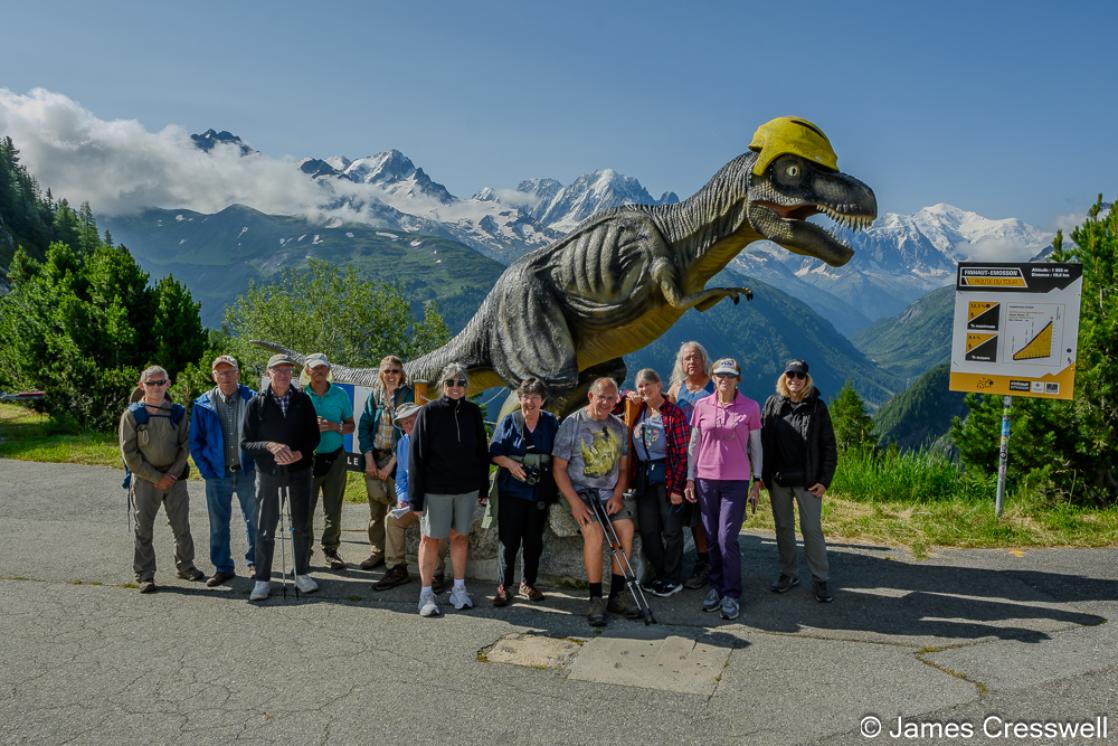
Photo Diary 2023
A selection of the best photos from the trip, with captions
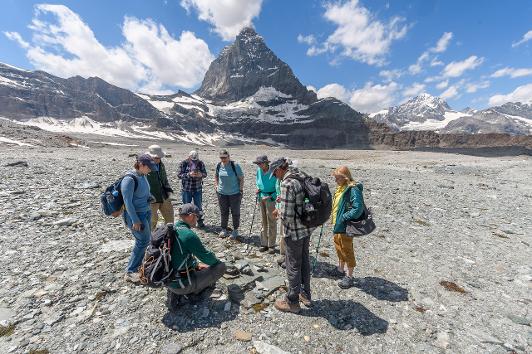
TRIP DIARY 2022
A summary of the trip with captioned photos
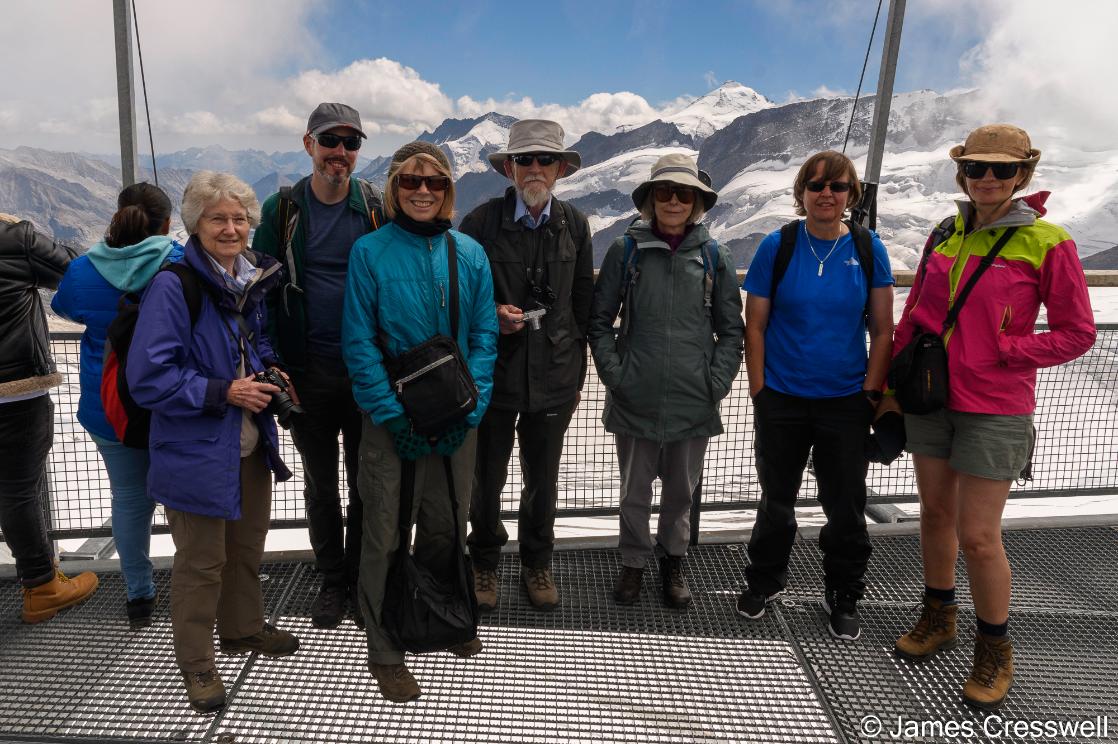
Switzerland - An Alpine Adventure (2023)
"Just some of the many excellent aspects of this trip: The well-prepared itinerary listed on the website was expanded in much more detail in the booklet we received at our initial meeting. At the conclusion of the trip, James posted 371 photos of all we had seen, and selected his "50 Best" for Facebook, complete with a travel diary. This has all been helpful to me in sharing the trip with friends. Many of my friends have commented on the travel diary and photos and have expressed an interest in traveling with GeoWorld. The small group of ten participants allowed everyone a chance to contribute and question the knowledgeable guides who were always willing to answer any query. We liked the mixture of well-travelled roads and off-the-beaten-path spots! Each mountain or pass seemed more striking and significant than the previous one. The loss of the glaciers was of course evident, which we all mourned. I am pleased that GeoWorld Travel offsets carbon!"
Barbara S., Wisconsin, USA
Review sent to us by email, August 2023
SWITZERLAND - AN ALPINE ADVENTURE (2022)
"Recently travelled to Switzerland with Geoworld travel to explore the geology, brilliantly led and well organised. We saw so much and the scenery was stunning, we also went to less touristy parts of Switzerland as well. Just need to read up on all the geology we have seen."
Teresa H., Essex, UK
Review was posted to Tripadvisor, August 2022
SWITZERLAND - AN ALPINE ADVENTURE (2022)
"Fabulous 10-day trip exploring the geology of the Alps in Switzerland. The professionally led and organised tour took us to exquisite locations such as the World Heritage Sites of the Jungfraujoch, the Matterhorn area at 3900m, the Glarus Sardona world as well as the Jura mountains and Lake Geneva Lavaux landscapes. We visited underground limestone caves, stood on African continental crust, on Tethys oceanic rocks and witnessed the signs of rapidly retreating alpine glaciers. James Cresswell and Dr David Buchs as experienced geologists led us admirably to a gradual understanding and appreciation of the complex geology of this extraordinary and beautiful country."

